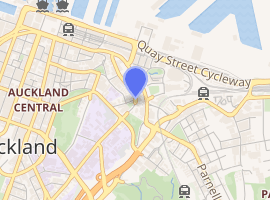Anzac Avenue, Auckland
Anzac Avenue is a street in Auckland, New Zealand's most populous city. It was constructed between 1914 and 1919 to link Beach Road to Symonds Street, and was named as a memorial to the troops who died in the Gallipoli campaign.[1]

| |
| Length | 0.6 km (0.4 mi) |
|---|---|
| Location | Auckland CBD, New Zealand |
| Postal code | 1010 |
| North end | Beach Road |
| South end | Symonds Street |
Demographics
| Year | Pop. | ±% p.a. |
|---|---|---|
| 2006 | 2,124 | — |
| 2013 | 2,568 | +2.75% |
| 2018 | 2,748 | +1.36% |
| Source: [2] | ||
The statistical area of Anzac Avenue, which is bounded by Beach Road, Parliament Street, Waterloo Quadrant, Princes Street and Emily Place, had a population of 2,748 at the 2018 New Zealand census, an increase of 180 people (7.0%) since the 2013 census, and an increase of 624 people (29.4%) since the 2006 census. There were 1,458 households. There were 1,422 males and 1,323 females, giving a sex ratio of 1.07 males per female. The median age was 30.6 years, with 90 people (3.3%) aged under 15 years, 1,215 (44.2%) aged 15 to 29, 1,269 (46.2%) aged 30 to 64, and 168 (6.1%) aged 65 or older.
Ethnicities were 45.9% European/Pākehā, 4.4% Māori, 2.6% Pacific peoples, 44.4% Asian, and 8.8% other ethnicities (totals add to more than 100% since people could identify with multiple ethnicities).
The proportion of people born overseas was 66.5%, compared with 27.1% nationally.
Although some people objected to giving their religion, 54.9% had no religion, 24.7% were Christian, and 16.2% had other religions.
Of those at least 15 years old, 1,320 (49.7%) people had a bachelor or higher degree, and 90 (3.4%) people had no formal qualifications. The median income was $37,200. The employment status of those at least 15 was that 1,527 (57.4%) people were employed full-time, 363 (13.7%) were part-time, and 135 (5.1%) were unemployed.[2]
History
Anzac Avenue, which started construction in 1914,[1] followed the route of Jermyn Street, but was renamed in 1916 to form a memorial to those who had died at Gallipoli, overriding a recommendation to call it Jellicoe Street.[3] There was an objection to the renaming, because the previous name honoured Captain John Jermyn Symonds, an early resident of the street and figure in the early history of Auckland.[4] A commemoration of the construction of the road was held in 1918, where the Governor-General, Arthur Foljambe, planted two puriri trees at the corner of Anzac Avenue and Waterloo Quadrant, and a score of trees were planted by others.[5] The road was described as busy in 1919 even before it was fully completed.[6] A tramline along Anzac Avenue was opened in February 1921.[7]
Notable locations

- Brooklyn Flats, 66–70 Emily Place, 1936, apartment block.[8]
- Eden Hall, 3 Eden Crescent, 1936, apartment block.[9]
- Logan Bank, 114 Anzac Avenue, 1917, remnants of a house built 1871 and occupied by John Logan Campbell, used as support for the construction of Anzac Avenue.[10]
- Station Hotel, 122 Anzac Avenue, 1931, hotel fronting on both Beach Road and Anzac Avenue.[11]
- Berrisville Flats, 152 Anzac Avenue, 1937, apartment block.[12]
- High Court Building, corner Anzac Avenue and Waterloo Crescent, 1868, originally the Supreme Court building, built in Gothic Revival style.[13]
- Braemar, 7 Parliament Street, 1901, apartment complex.[14]
- Middle Courtville, 9 Parliament Street, 1914, apartment complex.[15]
- Corner Courtville, 11 Parliament Street, 1919, apartment complex.[16]
References
- "Anzac Avenue, Auckland". New Zealand Ministry for Culture and Heritage. Retrieved 26 July 2020.
- "Statistical area 1 dataset for 2018 Census". Statistics New Zealand. March 2020. Anzac Avenue (134500). 2018 Census place summary: Anzac Avenue
- "Memory of Brave Men". New Zealand Herald. 1 December 1916. p. 9.
- "Changed Name Deplored". New Zealand Herald. 29 June 1917. p. 4.
- "Anzac Avenue - Tree-planting Ceremony". New Zealand Herald. 20 September 1918. p. 6.
- "New Traffic Outlet - Anzac Avenue Much Used". Auckland Star. 10 July 1919. p. 7.
- Bush, G. W. A. (1971). Decently and in Order: The Centennial History of the Auckland City Council. Collins. p. 231.
- "Brooklyn Flats". Register of Historic Places. Heritage New Zealand. Retrieved 26 July 2020.
- "Eden Hall". Register of Historic Places. Heritage New Zealand. Retrieved 26 July 2020.
- "Logan Bank". Register of Historic Places. Heritage New Zealand. Retrieved 26 July 2020.
- "Station Hotel (former)". Register of Historic Places. Heritage New Zealand. Retrieved 26 July 2020.
- "Berrisville Flats". Register of Historic Places. Heritage New Zealand. Retrieved 26 July 2020.
- "High Court Building". Register of Historic Places. Heritage New Zealand. Retrieved 26 July 2020.
- "Braemar". Register of Historic Places. Heritage New Zealand. Retrieved 26 July 2020.
- "Courtville (Middle Courtville)". Register of Historic Places. Heritage New Zealand. Retrieved 26 July 2020.
- "Courtville (Corner Courtville)". Register of Historic Places. Heritage New Zealand. Retrieved 26 July 2020.